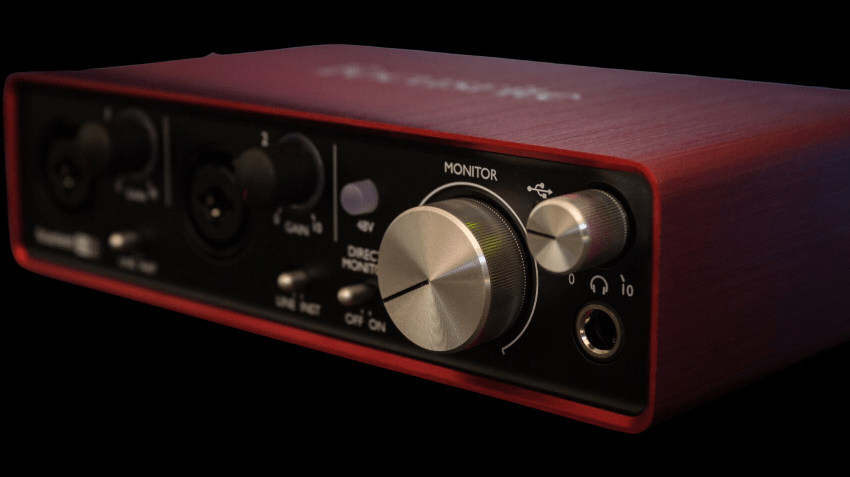
Wow! You are following your gut instinct, telling you that now is the time to figure out this recording thing. In doing so, you can get yourself into the game. That means you can and start turning your songwriting, rapping, or beat production into something just a bit more exciting. I’ve been there for sure, and I know exactly how it feels. What gear do you need? What is the best gear to buy? Which things can you get away with holding off buying until you’ve progressed a bit deeper into this particular interest? So assuming you already have a computer for recording in place, one question remains. How exactly you will get your microphone signal into that computer? So that brings us to the burning question about Audio Interface Benefits.
Is an Audio Interface Necessary?
Yes, an audio interface is an important and essential component in the recordist’s arsenal. In fact, the audio interface is the hub of connectivity for the studio setup.
After a computer, the audio interface would be the logical next sequential purchase. An audio interface benefits include a number of functions critical for your progression in music production. Those include the literal interfacing of various audio components, audio to digital, and digital to audio conversation. In many cases it includes basic signal amplification to amplify the source signal going into the computer. This would be for signal coming from a microphone or otherwise.
Don’t allow yourself to be daunted by the scientific particulars of all of these features. As you progress, you will become ever more initiated with audio production terminology and function. For now, let’s focus on keeping it simple, concise, and to the point. All of that is in order to provide you with as many usable takeaways as we possibly can.
The Point of Having an Audio Interface
Audio interface benefits are straightforward. It’s a dedicated tool for analog-to-digital conversion and vice versa, a vital part of your recording setup. You might think, “My computer has a sound card,”. but for long-term progress, building a toolkit of recording equipment is key.
Sure, you can create beats without it, but to advance, consider familiarizing yourself with well-reviewed entry-level units. Audio interface benefits offer serious producers the right connectivity in and out of the device. Regardless of whether you’re a hobbyist or planning for growth eventually you need to invest.
Regarding cost, “cheap” varies based on career trajectory. Focus on the point: audio interfaces are affordable nowadays, connecting your studio components effectively. Don’t stress; gradually save up for one. Its designated connectivity ensures a smooth workflow, processing analog-to-digital conversions. Audio companies prioritize current standards, resulting in competitive, industry-tuned devices.
The interface lets you convert source signals—microphone, guitar—into digital. It’s not just basic functionality; it adheres to PRO AUDIO standards. It enhances workflow with professional-grade options, centralizing connections. Microphone XLR, guitar cable, TRS, and speaker outs are common in basic units.
In essence, an audio interface is a bridge between analog and digital, offering quality and functionality within the norms of today’s audio industry.
The Difference an Audio Interface Makes.
Indeed, audio interfaces are meticulously engineered to elevate sound quality. These devices are finely tuned to faithfully reproduce signals without imparting any unwanted coloration. While pricier boutique options might promise superior outcomes, that’s not to disregard the value of entry-level choices. The competition within the industry drives manufacturers to create top-notch products that align with varying budgets.
However, it’s essential to note that not all products are created equal. To truly grasp the nuances, take time to explore comparison videos online. These videos pit devices from your entry point against each other, thoroughly testing their sonic capabilities and functionality.
After this research, you’ll confidently identify the interface that not only grants you organizational connectivity advantages but also propels you toward enhanced sound capturing and quality. Especially if you’re already equipped with a computer and DAW, acquiring a designated audio input emerges as the logical next step in your progression. This tool will further refine your setup, delivering the professional-grade results necessary for your musical journey.
This Device Should Be Usable for a Long Time.
The longevity of an audio interface hinges on current audio standards and technological progress. While its functionality can endure for a substantial period, rapid technological strides may outpace it. Generally, expect its effectiveness to span nearly a decade. However, around the five-year mark, consider keeping an eye on emerging technologies.
Opting to upgrade sooner may attract interest from those seeking second-hand devices. Yet, over time, its appeal might wane as it becomes outdated. Your work’s outcomes should guide any upgrade decisions. Avoid undue stress by not feeling obligated to prematurely switch to a more advanced model. Upgrade when it aligns with your needs and is strategically feasible.
Being Pragmatic
If your musical endeavor is self-sustaining and you’re making a living from engineering, upgrading to the next device makes sense. Conversely, if you’re content as a hobbyist, your current audio input should suffice for the foreseeable future. Your circumstances will dictate whether and when an upgrade is warranted, allowing you to maintain a pragmatic approach and ensuring that your tools align with your creative journey.
Conclusion
Having the right tool for the job is practical for any thing that we do. And while spending hard earned money on something that has yet to show promise is difficult. Without having the proper tools, refining your craft is more difficult. Sometimes its taking that leap of faith or putting some skin in the game that is exactly the kick in the pants that we need. Wherever you are in your musical journey, feel comfortable with taking one step at a time. I certainly wouldn’t recommend that you overreach. But, if I were a teacher and I was teaching a painting class and you visited ready to paint with your fingers you’d have demonstrated to me the wrong thing. And while, it isn’t about impressing others, I hope you can find the moral of that allegory.
Whatever happens, I hope that producing music brings you as much joy as you can handle, and I mean that sincerely. If you have cared enough to read through to the last word then I care enough to hope you the best in all of your future endeavors
Now go and get to it!
Good luck.
